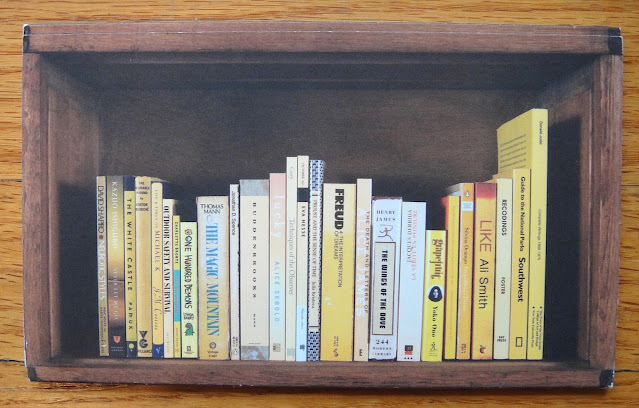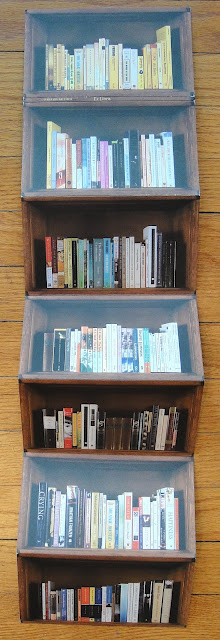This rather intriguing accordion arises from Balfour's practice of exploring the relationship between the textual and the visual. I'll leave it to this Professor of Print Media in the Department of Visual and Art History at York University, Toronto, Canada, to explain what she is attempting to do in this accordion.
"Ex Libris is both an accordion-style multiple and a series of seven digital prints. Initially bemused by interior decorators who reassemble clients' libraries into 'mountain' and 'valley' configurations, I set out to create meaningful and no less attractive concatenations of books. Acknowledging books as objects of beauty as well as substance, possessions people often refuse to get rid of even though they will never again be read, I reflect on what they might mean to their owner.
Drawing from my own idiosyncratic approach to shelving, I grouped and ordered my books in certain arrangements staged for this project. The titles visible on the books' spines act as as curious placeholders that are enigmatic or evocative, depending upon one's knowledge of the books in question. Beginning with the Yellow Shelf and culminating in Death Shelf, the work ends on a hopeful note with mention of the arfterlife. Overall, Ex Libris is an admittedly slow read.
Titles of Individual Shelves: Yellow, Writing, Characters, Doubles, Place and Time, Emotional Range, Death Shelf.
This book is a project inspired by Norman Bethune's personalized bookplate, which reads: "This Book Belongs to Norman Bethune and Friends." Bethune, the Canadian doctor eulogized by Mao Zedong, turned the proprietary notion of the bookplate upside down by this simple gesture. With a collectivist spirit, these bookplates read "This Book belongs to ______ and Friends." [http://www.barbarabalfour.ca/ex-libris1.html]
7 single-sided pages, each 4" x 7" and when fully opened 4' 1".















